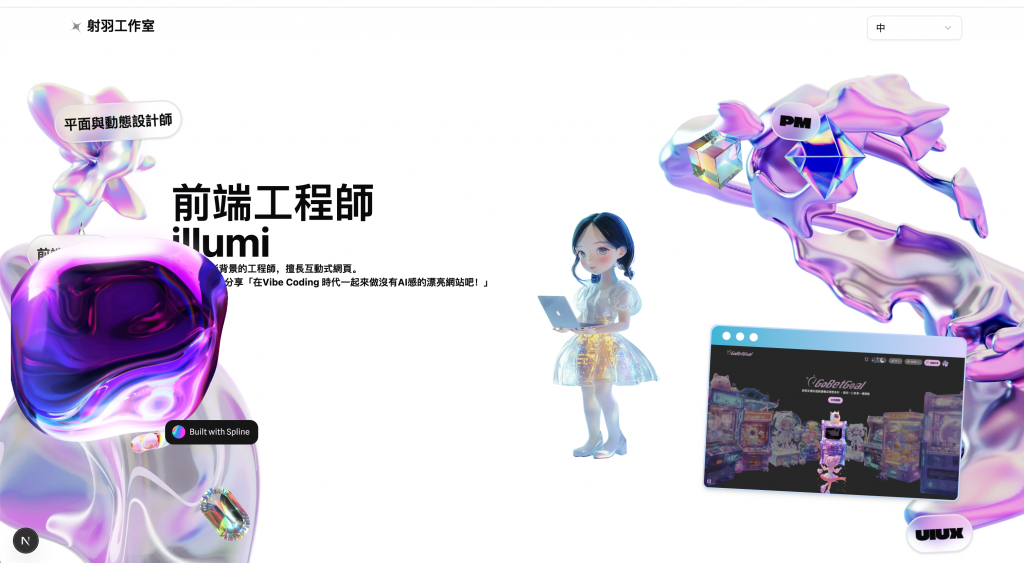嗨咿我是illumi,今天進入到最後一個單元了!
當你想要在網站中加入炫酷的3D元素時,第一個想到的可能是Three.js。但是等等!在你開始深入複雜的3D數學和WebGL之前,讓我們先來聊聊另一個選擇 - Spline。
今天我要和大家分享的是:為什麼在某些情況下,Spline可能是比Three.js更好的選擇,以及如何在Next.js/React專案中使用它。
Three.js 無疑是JavaScript 3D領域的王者,它提供了:
但是,Three.js也有其挑戰:
看似簡單,但要做出真正美觀的3D場景,你需要掌握:
Spline是一個專為網頁設計的3D設計工具,它讓你可以通過視覺化介面創建3D內容,然後輕鬆地嵌入到網站中。
# 安裝Spline React套件
npm install @splinetool/react-spline
# 如果使用TypeScript
npm install --save-dev @types/react @types/react-dom
創建一個簡單的Spline組件:
// components/SplineScene.tsx
'use client';
import Spline from '@splinetool/react-spline/next';
export default function SplineScene() {
return (
<div style={{ width: '100%', height: '100vh' }}>
<Spline
scene="https://prod.spline.design/你的場景ID/scene.splinecode"
/>
</div>
);
}
當你第一次看到 Spline 的官方範例時,可能會覺得:「哇,這也太簡單了吧!」
import Spline from '@splinetool/react-spline/next';
export default function Home() {
return (
<main>
<Spline scene="https://prod.spline.design/你的ID/scene.splinecode" />
</main>
);
}
只要三行程式碼,3D 場景就能在你的網站上運行!但當你真正在專案中使用時,卻發現需要寫一大堆複雜的程式碼:
為什麼會這樣?
官方的簡單範例能夠運作,是因為它假設了以下條件:
但實際專案中,這些條件幾乎不可能同時滿足。
在這個情境下,如果你直接使用官方範例,會遇到一連串的問題。
Error: async/await is not yet supported in Client Components
@splinetool/react-spline/next 是一個 async Server Component:
// Spline 原始碼
export default async function SplineNext({ ...props }: SplineProps) {
const hash = await getPreview(props.scene);
// ...
}
它會在伺服器端預先獲取場景的預覽圖片,提供更好的載入體驗。
但是,當你的頁面因為 next-intl 或其他原因需要使用 async 時,就會產生衝突:
// ❌ 這樣會報錯
"use client"; // 因為某些原因需要 client component
export default async function Page() { // async 在 client component 中不支援
return <Spline scene="..." />
}
import dynamic from 'next/dynamic';
// 使用普通的客戶端版本,不是 /next 版本
const Spline = dynamic(() => import('@splinetool/react-spline'), {
ssr: false, // 關鍵:禁用 SSR
});
這個改動看似簡單,但背後有重要的權衡:
| 特性 | /next 版本 |
普通版本 |
|---|---|---|
| 預覽佔位符 | ✅ 自動生成 | ❌ 需自行處理 |
| SSR 支援 | ✅ 完整支援 | ❌ 必須禁用 |
| 載入體驗 | 🌟 更好 | ⚠️ 較差 |
| 彈性 | ⚠️ 受限 | ✅ 更靈活 |
// 你的 GSAP 動畫突然不工作了
useEffect(() => {
gsap.from('.hero-title', { y: 50, opacity: 0 });
// 動畫沒有觸發!
}, []);
Spline 組件內部使用 Canvas 元素,並且會監聽大量的滑鼠和觸控事件:
// Spline 內部會做類似這樣的事
canvas.addEventListener('mousedown', handleMouseDown);
canvas.addEventListener('mousemove', handleMouseMove);
canvas.addEventListener('wheel', handleWheel);
// ... 還有很多
這些事件會冒泡到父元素,可能干擾頁面上的其他互動邏輯。
useEffect(() => {
const container = containerRef.current;
if (!container) return;
const stopEvent = (e: Event) => {
e.stopPropagation(); // 阻止事件冒泡
};
// 隔離所有可能造成干擾的事件
const events = ["mousedown", "mouseup", "mousemove", "wheel", "touchstart"];
events.forEach((event) => {
container.addEventListener(event, stopEvent);
});
return () => {
events.forEach((event) => {
container.removeEventListener(event, stopEvent);
});
};
}, []);
這個看似多餘的程式碼,實際上是在保護你的其他功能不被 Spline 意外影響。
// 你的其他元素突然無法點擊或顯示異常
<div className="popup">
<button>我點不到了!</button>
</div>
Canvas 元素會創建一個新的渲染層級(stacking context),可能會覆蓋或影響頁面上的其他元素。
<div
style={{
isolation: "isolate", // 創建獨立的渲染上下文
contain: "layout style paint", // 限制渲染影響範圍
}}
>
<Spline scene="..." />
</div>
這兩個 CSS 屬性的作用:
isolation: isolate:創建新的堆疊上下文,防止 z-index 混亂contain: layout style paint:告訴瀏覽器這個容器是獨立的,減少重繪範圍// Spline 場景不顯示或尺寸異常
<div>
<Spline scene="..." /> {/* 看不到任何東西! */}
</div>
根據 Spline 的原始碼,組件使用 ParentSize 來決定 Canvas 尺寸:
// Spline 原始碼
<ParentSize
parentSizeStyles={{ width: '100%', height: '100%' }}
// ...
>
如果父容器沒有明確的寬高,Canvas 就無法正確渲染。
<div
className="w-full h-full relative"
style={{
minHeight: "200px", // 至少要有最小高度
}}
>
<Spline scene="..." />
</div>
或者使用明確的像素值:
<div style={{ width: '400px', height: '400px' }}>
<Spline scene="..." />
</div>
Spline 場景可能因為多種原因載入失敗:
如果沒有處理這些錯誤,整個組件甚至整個頁面都可能崩潰。
const [hasError, setHasError] = useState(false);
const onError = (error: any) => {
console.error("Spline error:", error);
setHasError(true);
};
if (hasError) {
return (
<div className="w-full h-full flex items-center justify-center">
<div className="text-center">
<p className="text-gray-600">3D 場景載入失敗</p>
<button onClick={() => window.location.reload()}>
重新載入
</button>
</div>
</div>
);
}
return (
<Spline
scene="..."
onError={onError} // 關鍵:捕捉錯誤
/>
);
結合以上所有解決方案,這是一個生產級的 Spline 組件:
"use client";
import { useEffect, useRef, useState } from "react";
import dynamic from "next/dynamic";
// 動態載入,避免 SSR 問題
const Spline = dynamic(() => import("@splinetool/react-spline"), {
ssr: false,
loading: () => (
<div className="w-full h-full flex items-center justify-center">
<div className="animate-pulse text-gray-500">載入 3D 場景...</div>
</div>
),
});
interface BubbleProps {
scene: string;
className?: string;
}
export default function Bubble({ scene, className = "" }: BubbleProps) {
const containerRef = useRef<HTMLDivElement>(null);
const [isLoaded, setIsLoaded] = useState(false);
const [hasError, setHasError] = useState(false);
// 載入成功的回調
const onLoad = () => {
console.log("Spline scene loaded successfully");
setIsLoaded(true);
};
// 錯誤處理
const onError = (error: any) => {
console.error("Spline loading error:", error);
setHasError(true);
};
// 事件隔離:防止干擾頁面其他互動
useEffect(() => {
const container = containerRef.current;
if (!container) return;
const stopEvent = (e: Event) => {
e.stopPropagation();
e.stopImmediatePropagation();
};
const events = [
"mousedown", "mouseup", "mousemove",
"wheel", "touchstart", "touchmove", "touchend"
];
events.forEach((event) => {
container.addEventListener(event, stopEvent, { passive: false });
});
return () => {
events.forEach((event) => {
container.removeEventListener(event, stopEvent);
});
};
}, []);
// 錯誤狀態回退 UI
if (hasError) {
return (
<div className={`w-full h-full flex items-center justify-center bg-gray-50 rounded-lg ${className}`}>
<div className="text-center p-6">
<div className="w-16 h-16 mx-auto mb-4 bg-gray-200 rounded-full"></div>
<p className="text-gray-600 mb-3">無法載入 3D 場景</p>
<button
onClick={() => window.location.reload()}
className="px-4 py-2 bg-blue-500 text-white rounded hover:bg-blue-600"
>
重新載入
</button>
</div>
</div>
);
}
return (
<div
ref={containerRef}
className={`relative ${className}`}
style={{
isolation: "isolate", // CSS 隔離
contain: "layout style paint", // 限制渲染範圍
minHeight: "200px", // 確保容器有高度
width: "100%",
height: "100%",
}}
>
{/* 載入中狀態 */}
{!isLoaded && !hasError && (
<div className="absolute inset-0 flex items-center justify-center z-10">
<div className="animate-pulse text-gray-500">載入 3D 場景...</div>
</div>
)}
{/* Spline 場景 */}
<Spline
scene={scene}
onLoad={onLoad}
onError={onError}
/>
</div>
);
}
在你的頁面中:
// app/[locale]/page.tsx
import { getTranslations } from 'next-intl/server';
import Bubble from '@/components/Bubble';
export default async function HomePage() {
const t = await getTranslations('HomePage');
return (
<div>
<h1>{t('title')}</h1>
{/* 使用生產級的 Bubble 組件 */}
<div className="w-96 h-96 my-8">
<Bubble scene="https://prod.spline.design/你的ID/scene.splinecode" />
</div>
{/* 其他內容不會被影響 */}
<InteractiveSection />
</div>
);
}
這樣就成功放上去啦!

